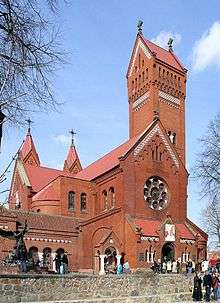Church of Saints Simon and Helena
Church of Saints Simon and Helena (Belarusian: Касцёл святых Сымона і Алены) (Polish: Kościół św. Szymona i św. Heleny w Mińsku) also known as the Red Church (Belarusian: Чырвоны касцёл) is a Roman Catholic church on Independence Square in Minsk, Belarus.
| Church of Sts. Simon and Helena Касцёл Свсв. Сымона і Алены | |
|---|---|
 The Red Church | |
| Religion | |
| Affiliation | Roman Catholic |
| Year consecrated | 1910 |
| Location | |
| Location | Minsk, Belarus |
| Country | |
| Geographic coordinates | 53°53′47.47″N 27°32′50.92″E |
| Architecture | |
| Architect(s) | Tomasz Pajzderski |
| Type | Church |
| Style | Neo-Romanesque |
| Completed | 1910 |
| Materials | Clay bricks |
This neo-Romanesque church was designed by Polish architects Tomasz Pajzderski and Władysław Marconi. The cornerstone was laid in 1905 and the church was completed in 1910. The bricks for its walls were sourced from Częstochowa, whilst the roof tiles came from Włocławek. Its construction was financed by Edward Woyniłłowicz (1847-1928), a prominent Belarusian-Polish landowner, businessman and civic activist. The church was named and consecrated in memory of Woyniłłowicz's two deceased children, Szymon and Helena.
History
In 1903, about 2,000 of Minsk's Roman Catholics wrote a petition to local authorities asking for a site to start building new Catholic church. This request was approved and construction started in 1905. The church was consecrated on September 20, 1910. On December 21, 1910, the church was opened. At this time, Minsk was part of the Minsk Governorate of the Russian Empire.
In 1921, Minsk became the capital of the Belorussian Soviet Socialist Republic (BSSR) within the Soviet Union and the church was sacked by the Red Army. In 1932, it was closed down by the Soviet authorities and was secularized. It was transferred to the State Polish Theatre of the BSSR. It was later used as a cinema. In 1941 during the Second World War, the German occupation administration returned the building to its original use as a church. After the war, it was again closed by the Soviet authorities and again used as a cinema.
In 1990, after two hunger strikes which were organized by the Minsk Catholic activists Anna Nicievska-Sinevicz and Edward Tarletski,[1][2][3] the building was returned to the Roman Catholic Church. The church's interior has been fully restored and it is now an important centre of religious, cultural and social life in Minsk. It has also become a centre for the revived Belarusian Greek Catholic Church.
In 2006, the earthly remains of Edward Wayniłłowicz and his wife were reburied in the church. In 1921, Wayniłłowicz, the donor who had the church built, was forced to leave his home and lands in Slutsk, Belarus, due to the territorial changes after the First World War as stipulated in the Peace of Riga. He resettled in Bydgoszcz, Poland where he died in 1928.
Mass is celebrated in the church in Belarusian, Polish, Lithuanian, and Latin.
References
- GAWIN, TADEUSZ (2013). "Początek odrodzenia" (PDF). Magazyn Polski. Archived from the original (PDF) on 2014-07-04.
- Gawin, Tadeusz (2010). POLSKIE ODRODZENIE NA BIAŁORUSI 1988-2005 (PDF). Wyższa Szkoła Administracji Publicznej im. Stanisława Staszica,Białystok. ISBN 978-83-60772-23-2. Archived from the original (PDF) on 2016-02-04. Retrieved 2016-02-09.
- Goliński, Cezary (1991). "Batalia o kościół". Głos znad Niemna. 5 (7).
External links
- Official website of parish St. Simeon and St. Helena in Minsk
- Unofficial website of the church
- Jurkau kutoczak — Юркаў куточак — Yury's Corner. Касьцёл Сьвятых Сымона і Алены (Чырвоны касцёл)
- Photos at Radzima.org
- Photos at Globus.tut.by
| Wikimedia Commons has media related to Church of Saints Simon and Helena, Minsk. |